You probably want to locate a great summer fishing spot for speckled trout, but it's proving to be quite the challenge.
Perhaps you've seen the great fishing reports posted on social media and want a slice of the action, but you have no idea where these anglers are going.
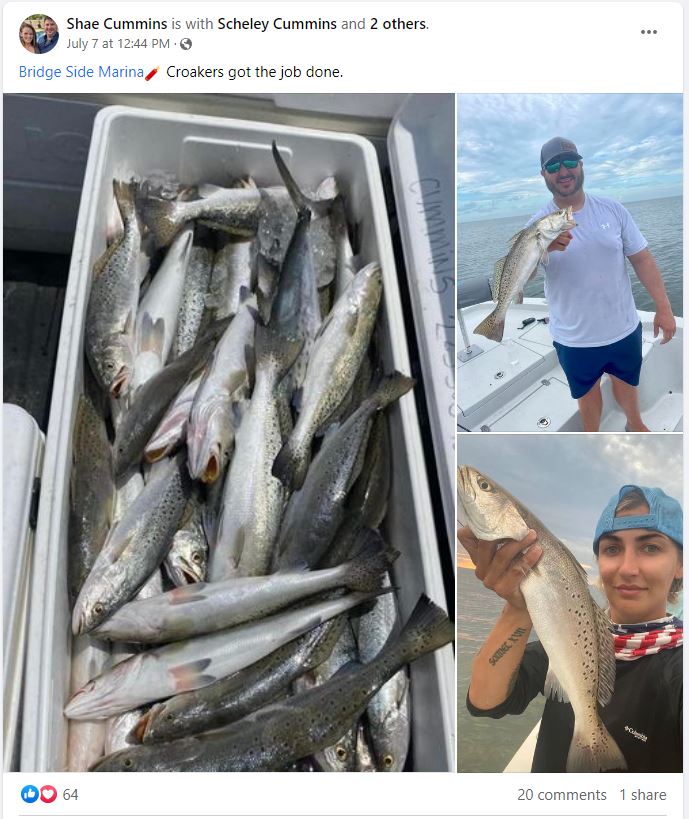
Click to Enlarge Shae and Paul have been posting great reports all summer long! They're excellent anglers and I'm thankful for their generous reporting.
Well, I don't either. That's because I don't have a crystal ball. Sorry.
But, I can tell you where to fish based upon the conditions we see during summer, and that's one thing covered in this guide: detailing exactly where you need to be casting a line for speckled trout (or redfish).
This guide will give you a few ideas and a strategy to give you an edge over everyone else trying to accomplish the same thing.
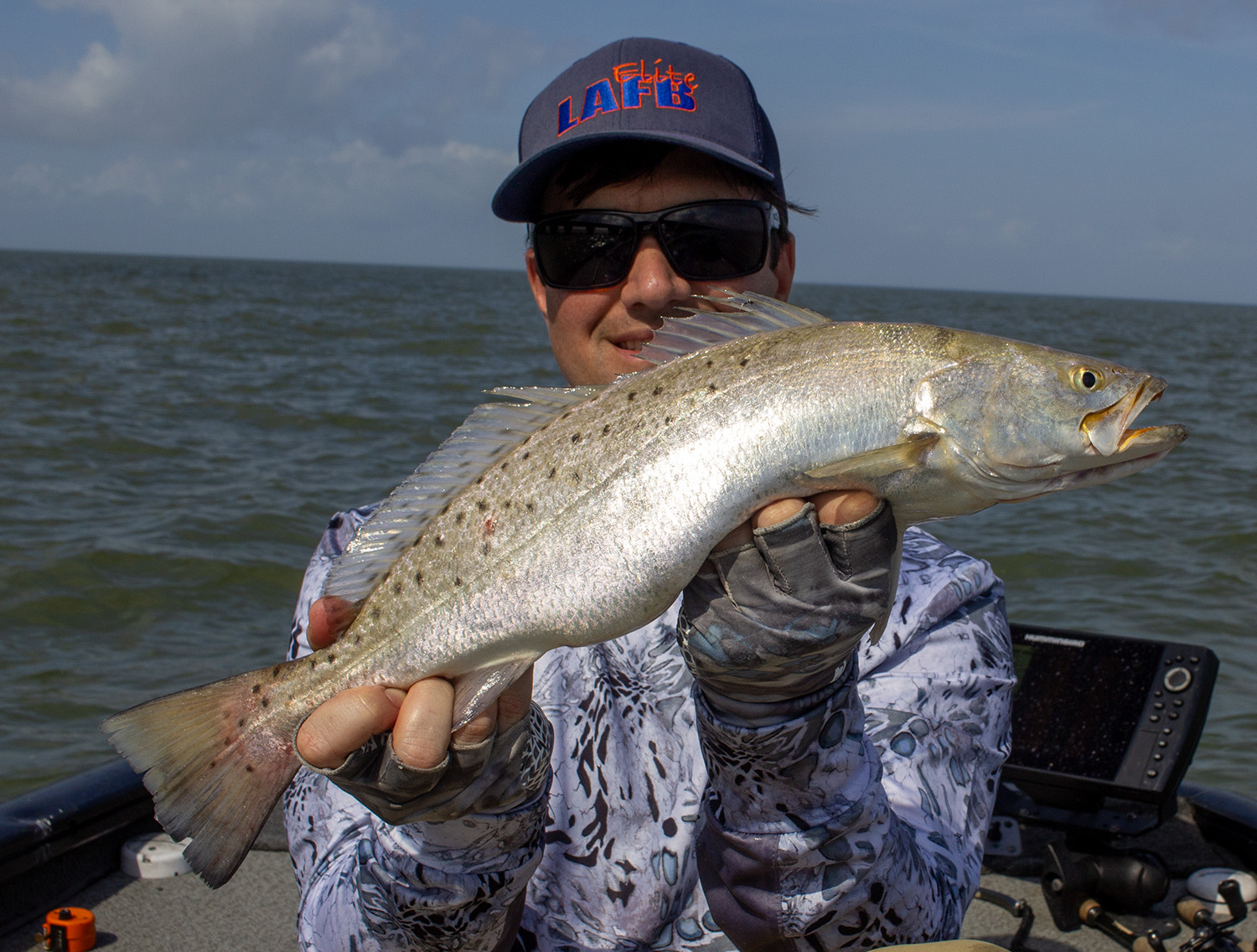
Use what you learn in this guide to find plenty of quality summer speckled trout!
Fish These Summer Fishing Spots for Speckled Trout
Louisiana's coast is a big one, and there's plenty of places summer specks and reds are hiding out, but if I had to pick just a handful, then I would be starting with this short list:
These are excellent summer fishing spots that have produced boxes of fish for as long as they have existed and inshore fishing has been a thing.
And I could pretty much leave it at that. Fish those five locations where you find them and you'll eventually figure it out.
What about exactly where and when?
The problem with the above short list is that it doesn't address exactly when and where to fish. If you look at a map of Louisiana's coast, you'd see that these types of fishing spots are everywhere.
So how do you know where they are exactly and when to fish them?
We need context to answer that question and, in order to do that, we must establish two big ideas:
Big Idea #1: The River Goes Up & Down
The Mississippi River goes up and it comes down. When it comes up during spring, the coast is flooded, like what you see in the satellite imagery below.
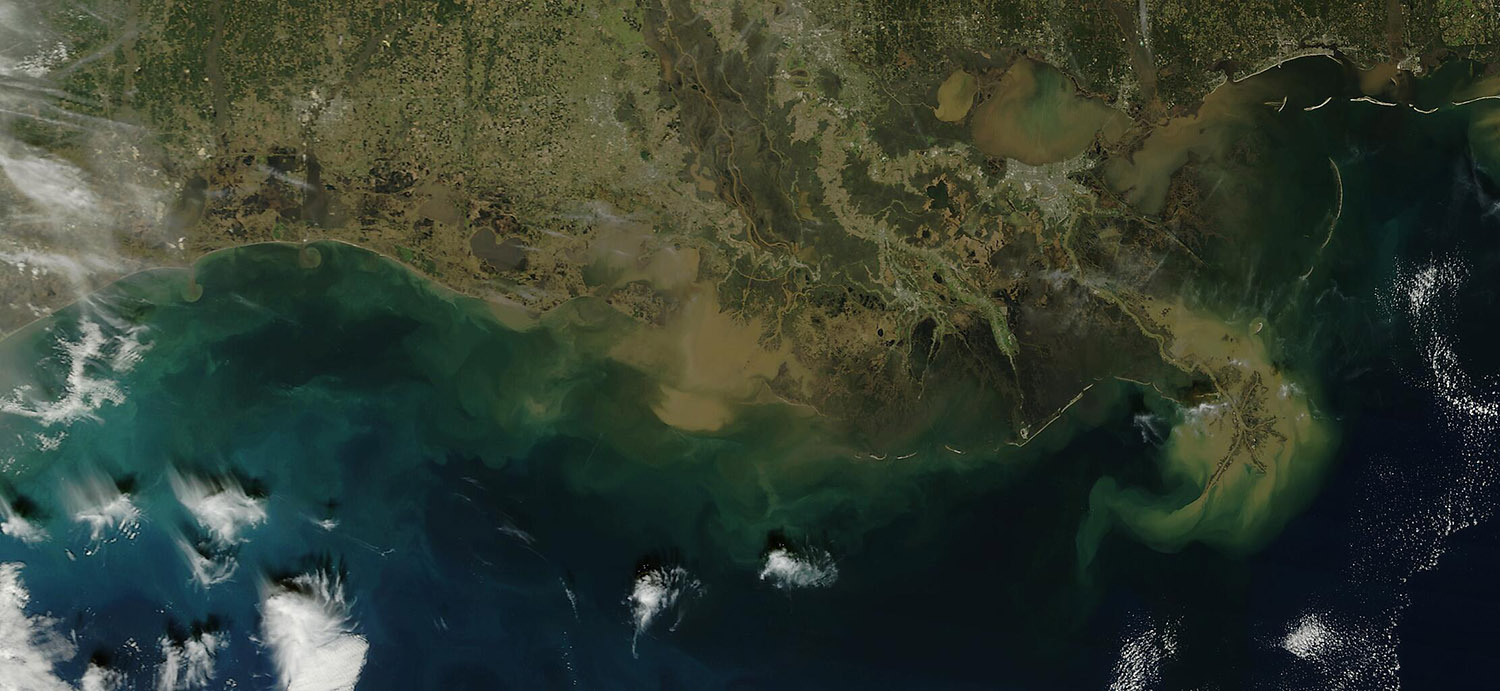
Click to Enlarge
When it is flooded in this manner, the water clarity plummets, causing most speckled trout and redfish to leave the area.
The lowered salinity also keeps these species away during their spawning seasons, especially trout. Speckled trout need about 15-17ppt to spawn, and that required salinity is not found in river water.
So, anywhere river water is flowing is not a good summer fishing spot for speckled trout and redfish.
But, when the Mississippi River eventually goes down (usually in the late summer), the surrounding area cleans up, becoming "clean and green", as seen in the below imagery. Note how this image contrasts greatly with the one above.
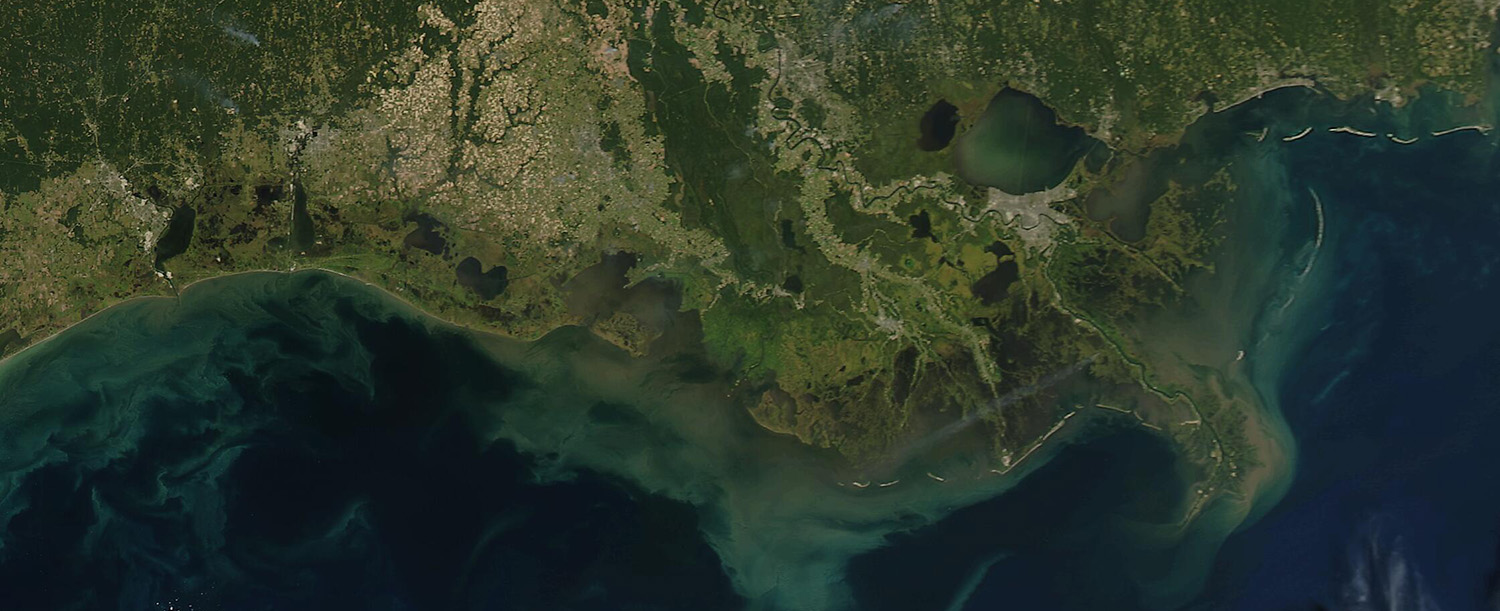
Click to Enlarge
It's also worth noting two other things about this phenomenon: When the river recedes, and the area cleans up, that same area may also become saltier as seawater from the Gulf of America creeps back in. This effect is detailed with salinity graphs in this article about The Saltening.
Then, after that, it is important to point out that the Mississippi River is the dominant player on Louisiana's coast, but there are other rivers such as the Atchafalaya, Sabine, Pearl, Amite and more. All of these were players in The Freshening and should be noted when planning your fishing trip.
So, whenever I refer to the Mississippi, I am also implying the same effect had from these rivers as well.
Anyway, let's wrap up this big idea: inshore species like speckled trout and redfish don't enjoy dirtier water. They do not like dirty water and will avoid it whenever possible.
So, when the Mighty Mississippi rages high, they leave the area she immediately floods. When she gets low, the surrounding area cleans up and they will move back in.
Which leads us to our next big idea.
Big Idea #2: Fish Will Push The Edge of New Feeding Opportunities
Speckled trout and redfish will go where they could not go before to take advantage of new feeding opportunities.
They do this to such an extent that they will leave places with otherwise good conditions to venture onto the bleeding edge of clearing water.
As the Mississippi falls and the surrounding coast clears up, you can count on fish showing up in places that weeks — or even days — before were covered in dirty water.
So, why does this happen?
I think this happens because the food chain grows from the bottom up in those locations.
As the river recedes, sediment falls out of suspension, making way for sunlight, that grows plankton, which feeds bait like menhaden and mullet.
Naturally, speckled trout and redfish follow.
These menhaden and mullet don't magically sprout out of nowhere, I think they swim into those locations, following the plankton.
I am no marine biologist, this is just what I see and what I think happens based upon those observations. I could be wrong and am willing to accept that when shown the appropriate evidence.
With that clear disclaimer out of the way, let's move on to combine both these ideas to reach our goal:
Identifying the best summer fishing spots for speckled trout and redfish
Now that we have these ideas in mind, let's put both together in order to identify where you need to be casting a line.
I'll keep this as simple as possible by breaking it down into where and when.
Where To Go
These are indeed the kinds of fishing spots mentioned earlier: rigs, oyster reefs, tidelines, beaches, islands and rock piles.
That list is not totally inclusive of every kind of fishing spot you'd do well to catch specks and reds, but it does entail a good chunk of the best kind of summer fishing spots worth your time.
And these are those spots that were covered in river water during the spring and early summer. These are the spots fish could not go for that part of the year, and they are easily found on maps, specifically Google Earth Desktop.
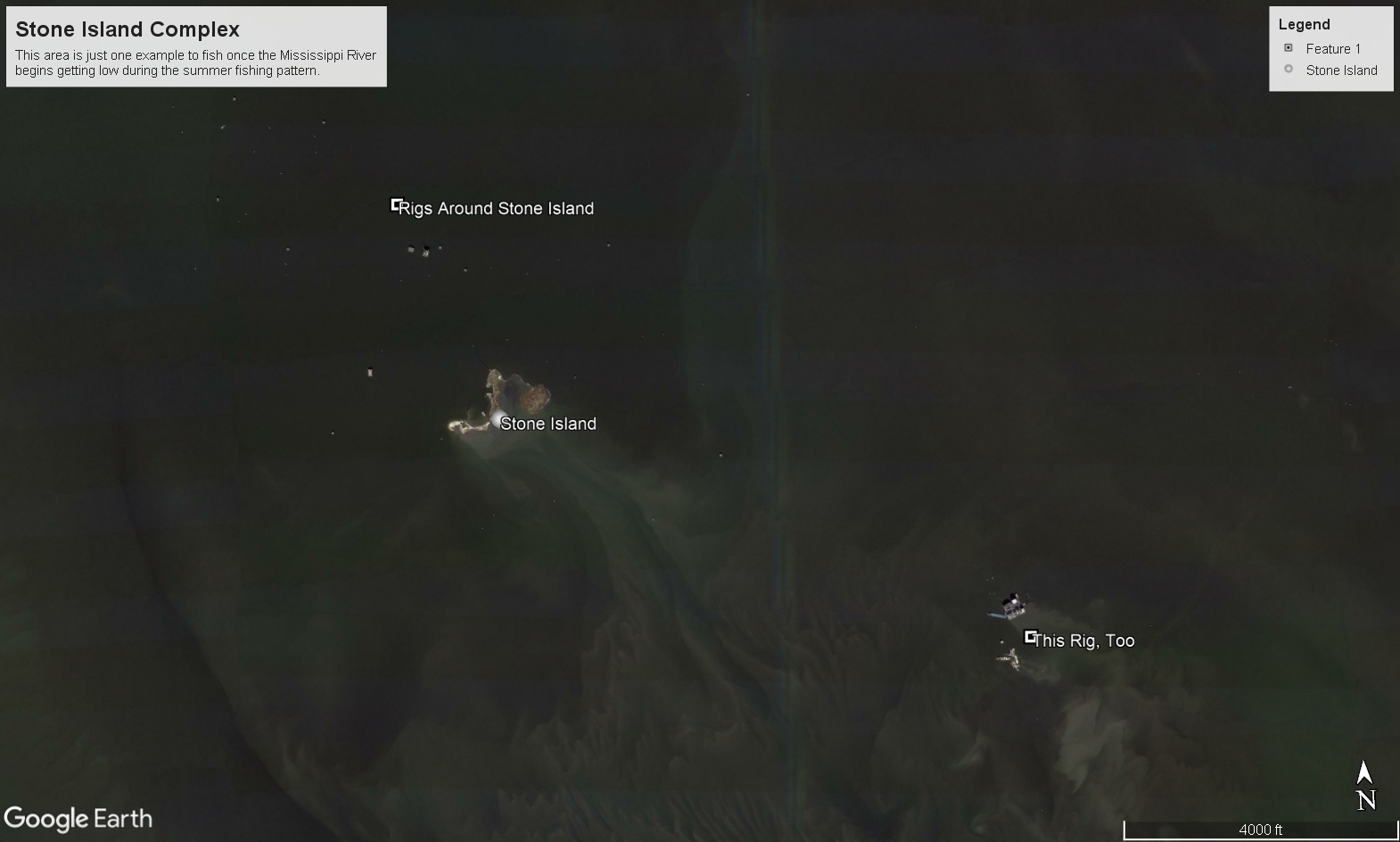
Click to Enlarge
For example, the Stone Island complex is a great summer fishing spot for speckled trout and redfish...when it's not covered in river water.
The same can be said for the rigs just outside of Ostrica or Breton Island. These are just examples on the east side of the river.
Examples on the west side include, but are not limited to:
When To Be There
You want to be there when the river begins falling. As the river water recedes and clears up, it becomes good for menhaden and mullet and, consequently, creates a good summer fishing spot for speckled trout and redfish.
But how do you know when to be there?
You can do that with the following tools:
Tools For Monitoring River Stages & Water Clarity
There are several resources I use to know how high the Mississippi River is (or any river) as well as how much the water has cleaned up and what else is going on out there.
I'll briefly touch on them here, but know that my Fishing Trip Planning Resources guide details each to make the most of them.
Carrollton Gauge at Mississippi River
There are many gauges along the Mississippi River used to determine her height, but the most commonly used one is the Carrollton Gauge, near the U.S. Army Corps of Engineers building.
When referencing it I prefer to use this link for current observations and predictions, then this link to obtain historical observations (for research purposes).
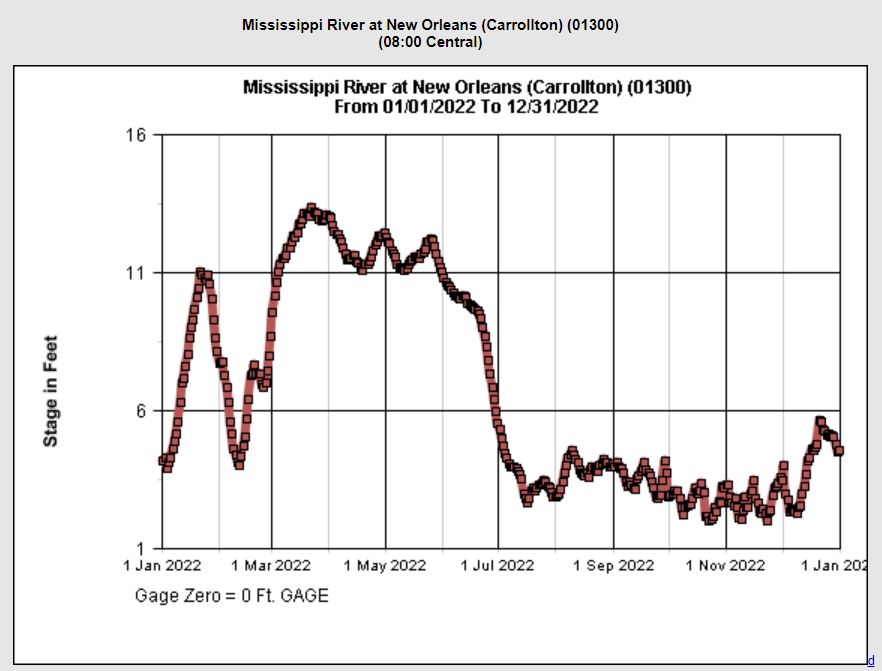
Click to Enlarge Using river gauges is a good way to predict what's going to happen to the fishing, long before people start posting about it on social media. Here you can see when the Mighty Mississippi began falling in June, which is typical. That's when I'd begin looking at nearby summer fishing spots.
United States Geological Survey Water Monitoring Stations
For all other rivers and streams I use the USGS National Water Information System. This mapper helps you scroll around to see which ones are in the area you are fishing.
I also use these monitoring stations for checking salinity for whatever body of water, both current observations and historical.
Rising salinity indicates receding river water, remember that!
MODIS Daily Satellite Imagery
This a system of two satellites that orbit the Earth and take a picture of its surface every day. This includes Louisiana, but be warned: sometimes the images are shoddy or missing, there's significant sun glare or cloud cover.
But this is a good tool for seeing the larger bodies of water and how they're affected (or not) by river water.
Fishing Reports for Speckled Trout Summer Fishing Spots
Good fishing reports are boots-on-ground information as to what's actually happening out there.
I would suggest checking LAFB Elite's Community as the best inshore fishing reports and discussion are found there. No social media required!
Checking other Facebook groups couldn't hurt if you don't mind scrolling through endless spam posts, promotions and bragging reports, but I wouldn't expect anyone to hold your hand and point to where you need to go.
Don't be naïve!
Instead, I suggest using fishing reports as an indicator for how a general area is doing. Reporting on the location of dirty water is a common practice. I'd also read between the lines to extract information not readily pointed out.
For example: if someone posts a wade fishing report, then they were certainly fishing islands and/or beaches. They weren't fishing rigs or oyster reefs, as those locations are too deep to wade fish.
So, then I'd ask myself, "What islands are influenced by river water?", then set out to answer that question and gain an idea as to which summer fishing spot for speckled trout is worth my time.
See the level of detective work being used here? That is much better than begging for handouts on social media.
The Best Kind of Fishing Report is....
The very best kind of fishing report you can find for summer fishing spots for speckled trout and redfish are not those posted today, this week, or even last month.
You want to read those that were posted last year, and the years before that, but during the time of year you plan to fish.
This is because fishing patterns repeat themselves every year, and reading past fishing reports is something like a cheat code to discovering those patterns ahead of everyone else.
Believe me, this is a real thing.
One would have to be an incredibly dumb and short-sighted human being to genuinely believe that fishing reports are good based only upon their recentness.
Just typing that literally made me laugh out loud because I am thinking of all the poor souls on social media who have said so, but never have any fishing reports of their own to prove the substance of their belief.
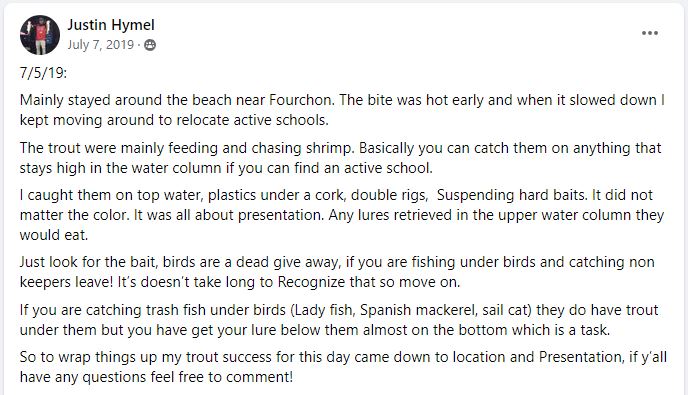
Click to Enlarge Justin is a great angler, and this excellent report reflects not just his ability to find and catch fish, but also his generosity and willingness to help others. Thank you, Justin!
Finding those old fishing reports will take a little work on your part: diving into the search function and scrolling through the proverbial haystack to find that useful needle.
That alone could be enough to crack the code on what specific fishing spots turn on when the nearest river reaches a certain stage as it begins falling.
Then you could be the first person fishing there ahead of the Flotilla!
So Now You Know How To Find Summer Fishing Spots For Speckled Trout & Redfish
Successfully catching limits of fish is not just knowing where to fish, but when to fish. It's all about fishing the conditions, and that's what you just learned here in this guide.
If you found this to be helpful then you'll really love Inshore Fishing 101! Remember the three kinds of fishing knowledge:
It's that second and third kind of knowledge that will really unlock your fishing trips. This way you save time, money and heartache, and get more to the good stuff: enjoying the best summer fishing spots for speckled trout and redfish.
This way you enjoy catching, have plenty of fillets for dinner and maybe even practice a little catch and release.
So you know, Inshore Fishing 101 is only available inside my membership LAFB Elite, where you will find even more courses to empower inshore anglers like yourself.
No More Frustration
I too was frustrated with the many times I went and fished all day only to come home with little to nothing.
I have been an Elite member now for a couple of months, and while I haven't loaded the boat yet, I can say that I have learned a lot.
Some of the stuff that Devin teaches, I think that I already was doing but not understanding why. Plus I learned the things that "I didn't know that I did not know".
I am very pleased with LAFB Elite, and recommend it to anyone who's on the fence considering if they should join or not.
Like Devin says: it costs less that a bucket of live shrimp, so what do you have to lose?
Best Investment I've Made
Yep, Inshore Fishing 101 is the best investment I’ve ever made in catching fish. (Keyword CATCHING)
I was an early member. I think if for some reason I lost my membership that I would buy another one!
I have been unsuccessful at finding anything like Inshore Fishing 101 anywhere else.
Thanks, Devin!
Texas Angler Here
Being from Texas, I can say that joining LAFB Elite — even though it's targeting Louisiana — has been worth every penny! Hell, the angler's mindset you learn there alone applies to all fishing, even freshwater bass fishing!
Inshore Fishing 101 especially has been a great tool to learn the process to finding and catching speckled trout and redfish on my own.
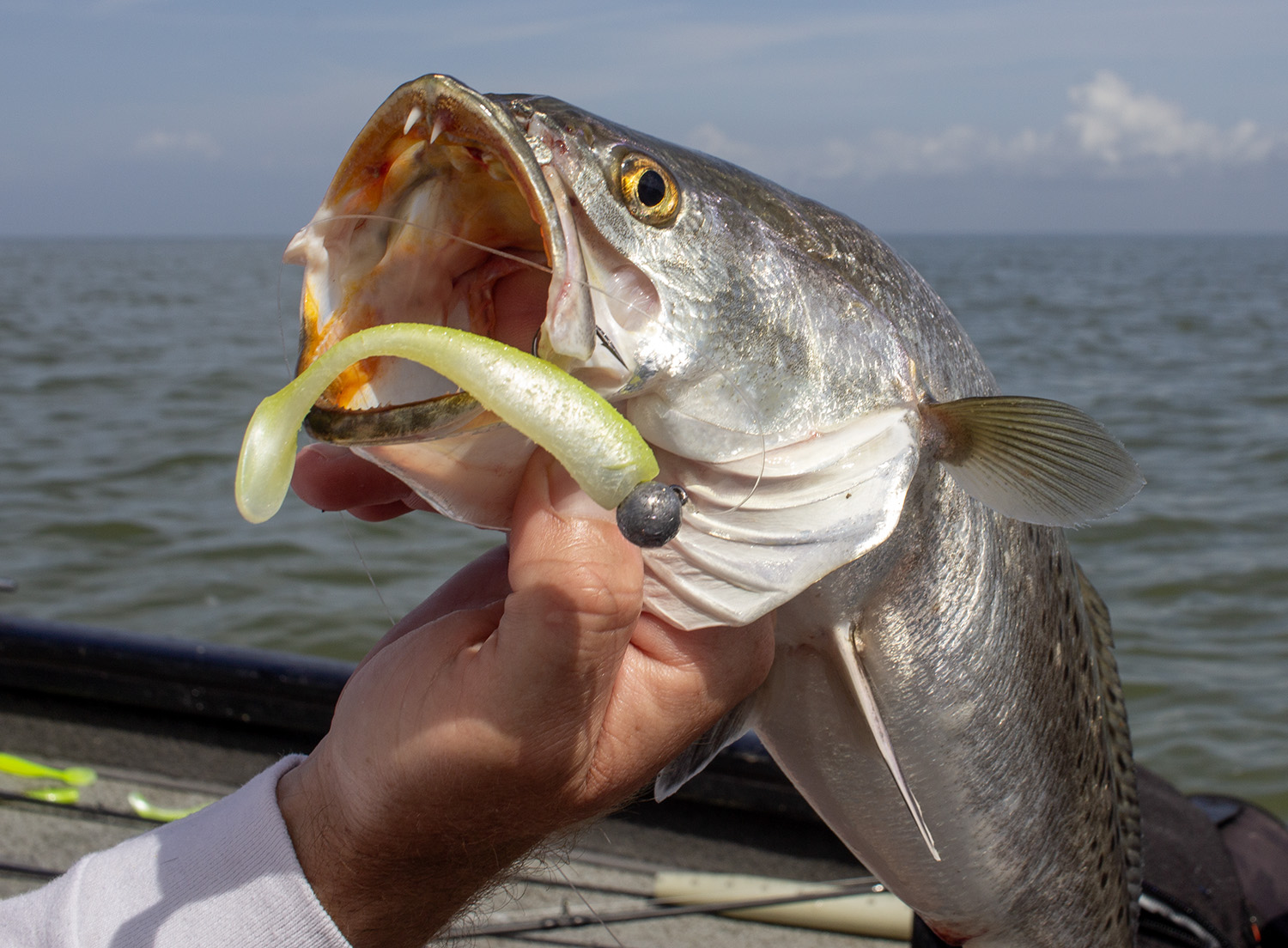
LAFB Elite arms you with the practical fishing know-how you need to consistently catch speckled trout during the summer pattern.
What do you think? How do you find summer fishing spots for speckled trout?
If you made it this far, and read this much, then I thank you for doing so.
Being so interested to learn more about inshore fishing — in this day and age of on-demand, algorithmically generated video entertainment — well, that's a rare thing.
So, I shall take it a step further: what do you think?
Have you ever implemented this strategy of timing the conditions with location to stay on the best fishing action?
Let me know in the comments section below!

Yeah, those are all great locations to fish!
But I think that if you hit rigs closer to the river you’d get back on the speckled trout. They don’t have to be terribly close to the river, just the ones southeast of the Long Rocks is a good place to start.
Anyway, thanks for reading and taking time to comment!
Thanks Devin,
Good article! I’ve been going to the ‘far east’ Biloxi Marsh (Door Point, Elephant Point, Martin Island, etc.) and found easy fishing under the birds during the brown shrimp run in May and June, but that’s mostly over now, and I know I need better strategies. Island points have been good, and I’ve picked up a few fish around the few well platforms in Chandeleur Sound, but I’ll start looking for closer-in spots that were too fresh or too dirty back in that May/June time frame…
Good read, Thanks for the info.